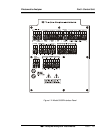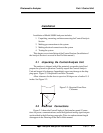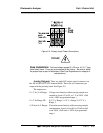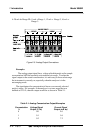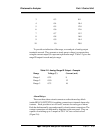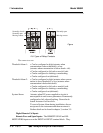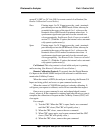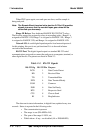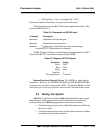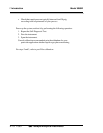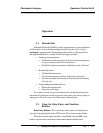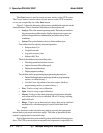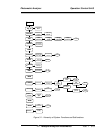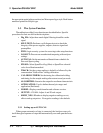
Part I: 2-7
Teledyne Analytical Instruments
Photometric Analyzer Part I: Control Unit
accept 0 V (OFF) or 24 V dc (ON) for remote control of calibration (See
Remote Calibration Protocol below.)
Zero: Floating input. 5 to 24 V input across the + and – terminals
puts the analyzer into the ZERO mode. Either side may be
grounded at the source of the signal. 0 to 1 volt across the
terminals allows ZERO mode to terminate when done. A
synchronous signal must open and close the external zero
valve appropriately. See Remote Probe Connector at end of
section 3.3. (With the -C option, the internal valves automati-
cally operate synchronously).
Span: Floating input. 5 to 24 V input across the + and – terminals
puts the analyzer into the SPAN mode. Either side may be
grounded at the source of the signal. 0 to 1 volt across the
terminals allows SPAN mode to terminate when done. A
synchronous signal must open and close the external span
valve appropriately. See Remote Probe Connector at end of
section 3.3. (With the -C option, the internal valves automati-
cally operate synchronously.)
Cal Contact: This relay contact is closed while analyzer is spanning
and/or zeroing. (See Remote Calibration Protocol below.)
Remote Calibration Protocol: To properly time the Digital Remote
Cal Inputs to the Model 5000B Analyzer, the customer's controller must
monitor the Cal Relay Contact.
When the contact is OPEN, the analyzer is analyzing, the Remote Cal
Inputs are being polled, and a zero or span command can be sent.
When the contact is CLOSED, the analyzer is already calibrating. It
will ignore your request to calibrate, and it will not remember that request.
Once a zero or span command is sent, and acknowledged (contact
closes), release it. If the command is continued until after the zero or span is
complete, the calibration will repeat and the Cal Relay Contact (CRC) will
close again.
For example:
1) Test the CRC. When the CRC is open, Send a zero command
until the CRC closes (The CRC will quickly close.)
2) When the CRC closes, remove the zero command.
3) When CRC opens again, send a span command until the CRC
closes. (The CRC will quickly close.)
4) When the CRC closes, remove the span command.



